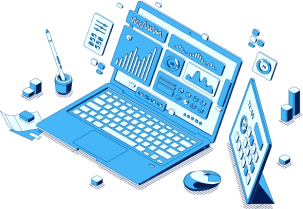Related courses
See All CoursesBeginner
Introduction to Python
Python is a high-level, interpreted, general-purpose programming language. Distinguished from languages such as HTML, CSS, and JavaScript, which are mainly utilized in web development, Python boasts versatility across multiple domains, including software development, data science, and back-end development. This course will guide you through Python's fundamental concepts, equipping you with the skills to create your own functions by the conclusion of the program.
Beginner
Introduction to JavaScript
Learn the fundamentals of JavaScript, the backbone of dynamic web development. Discover essential concepts like syntax, variables, data types, and operators. Explore how to use conditional statements, loops, and functions to create interactive and efficient programs. Master the building blocks of JavaScript and lay the groundwork for more advanced programming skills.
Beginner
Java Basics
Learn the fundamentals of Java and its key features in this course. By the end, you'll be able to solve simple algorithmic tasks and gain a clear understanding of how basic console Java applications operate.
Build Your SaaS Products
Building and Selling SaaS Products Independently

Entrepreneurship has become more attractive than ever before. Countless individuals are aspiring to create and sell their own products or services. One avenue that has gained immense popularity is Software as a Service (SaaS), which offers entrepreneurs the opportunity to develop, market, and sell software applications to a global audience.
Understanding SaaS and Its Significance

Software as a Service (SaaS) refers to a software distribution model in which applications are hosted by a third-party provider and made available to customers over the internet. Unlike traditional software products that require installation and maintenance on users' devices, SaaS solutions are accessible via web browsers or dedicated client applications, offering scalability, flexibility, and ease of use.
The importance of SaaS lies in its transformative impact on businesses and consumers alike. For businesses, SaaS offers cost-effective solutions for accessing essential software tools without the need for significant upfront investment in hardware or infrastructure. From customer relationship management (CRM) systems to project management platforms and accounting software, SaaS empowers organizations to streamline operations, improve efficiency, and drive growth.
Similarly, for consumers, SaaS products represent convenience, accessibility, and affordability. From cloud storage and productivity suites to entertainment streaming services and online collaboration tools, SaaS has become an integral part of everyday life, enabling individuals to access software applications on-demand, anytime, anywhere.
Run Code from Your Browser - No Installation Required

Building Your Own SaaS Product

The prospect of building and selling your own SaaS product as a solopreneur may seem daunting, but it is entirely feasible with the right approach and mindset. Here are some key steps to consider:
- Identify a Niche: Start by identifying a specific market niche or problem that you are passionate about solving. Conduct market research to assess demand, competition, and potential customer pain points.
- Develop a Minimum Viable Product (MVP): Rather than aiming for perfection from the outset, focus on building a minimum viable product (MVP) that addresses the core needs of your target audience. This allows you to validate your idea and gather feedback from early adopters before investing significant time and resources.
- Embrace Agile Development: Adopt agile development methodologies to iterate quickly, respond to customer feedback, and refine your product over time. Break down your development roadmap into manageable sprints, prioritizing features based on user feedback and market demand.
- Ensure Scalability and Reliability: Design your SaaS product with scalability and reliability in mind, anticipating future growth and user demand. Leverage cloud-based infrastructure and scalable architecture to accommodate increasing traffic and usage without compromising performance or user experience.
- Focus on User Experience: User experience (UX) is paramount in the success of any SaaS product. Invest in intuitive design, responsive interfaces, and seamless workflows to delight your users and keep them engaged.
Selling Your SaaS Product

Once you have developed your SaaS product, the next step is to bring it to market and attract customers. Here are some strategies for selling your SaaS product effectively:
- Define Your Pricing Model: Determine a pricing strategy that aligns with the value proposition of your SaaS product and resonates with your target market. Consider subscription-based pricing, tiered pricing plans, or usage-based pricing models depending on your product offering and customer preferences.
- Create Compelling Marketing Materials: Develop compelling marketing materials, including a website, landing pages, demo videos, and promotional content, to showcase the benefits of your SaaS product and attract potential customers.
- Build a Strong Online Presence: Leverage digital marketing channels such as social media, content marketing, email campaigns, and search engine optimization (SEO) to increase visibility and drive traffic to your website. Engage with your target audience through thought leadership, educational content, and community building initiatives.
- Offer Free Trials or Freemium Versions: Consider offering free trials or freemium versions of your SaaS product to allow customers to experience its value firsthand before committing to a paid subscription. This can help lower the barrier to entry and encourage adoption.
- Provide Excellent Customer Support: Prioritize customer satisfaction and retention by offering responsive customer support, clear communication, and timely resolution of issues. Happy customers are more likely to become loyal advocates for your SaaS product and help drive word-of-mouth referrals.
Lucrative SaaS Ideas

While the prospect of building and selling your own SaaS product is enticing, identifying the right idea is crucial for success. Here are some promising SaaS ideas to consider:
- Project Management Tools: With the increasing prevalence of remote work and distributed teams, there is a growing demand for project management software that facilitates collaboration, communication, and task management. Consider developing a SaaS solution tailored to specific industries or niche markets, offering features such as Gantt charts, Kanban boards, and time tracking capabilities.
- Online Learning Platforms: The e-learning market has experienced significant growth in recent years, driven by the increasing demand for online education and professional development. Create a SaaS platform that enables individuals and organizations to create, deliver, and monetize online courses, providing tools for course creation, student management, and assessment.
- Customer Relationship Management (CRM) Systems: Businesses of all sizes rely on CRM software to manage customer relationships, track sales activities, and analyze customer data. Develop a SaaS CRM solution that offers customization, integration with other business systems, and advanced analytics capabilities to help companies improve sales and customer service processes.
- Marketing Automation Software: In an increasingly competitive digital landscape, marketers seek automation tools to streamline marketing campaigns, nurture leads, and measure campaign effectiveness. Build a SaaS platform that provides automation features such as email marketing, social media management, lead scoring, and analytics to empower marketers to achieve their goals more efficiently.
- Cloud Storage and File Sharing: With the growing volume of digital content generated by individuals and businesses, there is a constant need for reliable cloud storage and file sharing solutions. Create a SaaS platform that offers secure cloud storage, file synchronization, and collaboration features, catering to both personal and enterprise users.
- HR and Employee Management Software: Human resources departments require robust software solutions to manage employee data, streamline HR processes, and ensure compliance with regulations. Develop a SaaS HRMS (Human Resource Management System) that encompasses features such as payroll management, performance evaluation, recruitment, and employee self-service portals.
- Customer Support and Helpdesk Solutions: Businesses strive to deliver exceptional customer support experiences to enhance customer satisfaction and loyalty. Build a SaaS helpdesk platform that centralizes customer inquiries, automates ticket routing and resolution, and provides multichannel support options such as email, live chat, and social media integration.
- Financial Management Tools: Small businesses and freelancers often struggle with financial management tasks such as invoicing, expense tracking, and accounting. Create a SaaS platform that simplifies financial workflows, offering features such as invoicing templates, expense categorization, tax calculation, and integration with accounting software.
- Healthcare Management Systems: The healthcare industry faces unique challenges in managing patient data, scheduling appointments, and maintaining compliance with regulations such as HIPAA. Develop a SaaS healthcare management system that caters to healthcare providers, offering electronic health records (EHR), appointment scheduling, telemedicine capabilities, and billing functionalities.
- Event Management Platforms: Event organizers require comprehensive solutions to plan, promote, and manage events of all sizes, from conferences and trade shows to webinars and virtual events. Create a SaaS platform that offers event registration, ticketing, attendee management, session scheduling, and analytics features to streamline the event planning process.
Start Learning Coding today and boost your Career Potential

Conclusion
In conclusion, building and selling your own SaaS product as a solopreneur is indeed achievable with the right combination of creativity, determination, and strategic thinking. By understanding the fundamentals of SaaS, identifying market opportunities, embracing agile development practices, and executing effective marketing and sales strategies, you can turn your entrepreneurial vision into a successful reality.
FAQs
Q: What does SaaS stand for, and what does it refer to?
A: SaaS stands for Software as a Service, which refers to a software distribution model where applications are hosted by a third-party provider and made accessible to customers over the internet.
Q: What are some key characteristics of SaaS products?
A: SaaS products offer scalability, flexibility, and ease of use. They are accessible via web browsers or dedicated client applications, eliminating the need for installation and maintenance on users' devices.
Q: What are some key steps to consider when building your own SaaS product?
A: Key steps include identifying a niche, developing a Minimum Viable Product (MVP), embracing agile development, ensuring scalability and reliability, and focusing on user experience.
Q: What strategies can you employ to effectively sell your SaaS product?
A: Strategies include defining a pricing model, creating compelling marketing materials, building a strong online presence through digital marketing channels, offering free trials or freemium versions, and providing excellent customer support.
Q: What are some potential rewards of building and selling a profitable SaaS product?
A: Building and selling a profitable SaaS product can be immensely gratifying, both personally and professionally. It allows solopreneurs to turn their entrepreneurial vision into a successful reality and potentially achieve financial independence.
Related courses
See All CoursesBeginner
Introduction to Python
Python is a high-level, interpreted, general-purpose programming language. Distinguished from languages such as HTML, CSS, and JavaScript, which are mainly utilized in web development, Python boasts versatility across multiple domains, including software development, data science, and back-end development. This course will guide you through Python's fundamental concepts, equipping you with the skills to create your own functions by the conclusion of the program.
Beginner
Introduction to JavaScript
Learn the fundamentals of JavaScript, the backbone of dynamic web development. Discover essential concepts like syntax, variables, data types, and operators. Explore how to use conditional statements, loops, and functions to create interactive and efficient programs. Master the building blocks of JavaScript and lay the groundwork for more advanced programming skills.
Beginner
Java Basics
Learn the fundamentals of Java and its key features in this course. By the end, you'll be able to solve simple algorithmic tasks and gain a clear understanding of how basic console Java applications operate.
Should I Commit package-lock.json
Demystifying the package-lock.json file
by Oleh Subotin
Full Stack Developer
Apr, 2024・4 min read

Demystifying JavaScript and Nodejs
Understanding the Relationship Between the JavaScript and Nodejs
by Oleh Subotin
Full Stack Developer
Mar, 2024・5 min read

Accidental Innovation in Web Development
Product Development
by Oleh Subotin
Full Stack Developer
May, 2024・5 min read

Content of this article